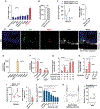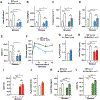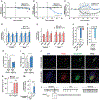Mediation of the Acute Stress Response by the Skeleton
- PMID: 31523009
- PMCID: PMC6834912
- DOI: 10.1016/j.cmet.2019.08.012
Mediation of the Acute Stress Response by the Skeleton
Abstract
We hypothesized that bone evolved, in part, to enhance the ability of bony vertebrates to escape danger in the wild. In support of this notion, we show here that a bone-derived signal is necessary to develop an acute stress response (ASR). Indeed, exposure to various types of stressors in mice, rats (rodents), and humans leads to a rapid and selective surge of circulating bioactive osteocalcin because stressors favor the uptake by osteoblasts of glutamate, which prevents inactivation of osteocalcin prior to its secretion. Osteocalcin permits manifestations of the ASR to unfold by signaling in post-synaptic parasympathetic neurons to inhibit their activity, thereby leaving the sympathetic tone unopposed. Like wild-type animals, adrenalectomized rodents and adrenal-insufficient patients can develop an ASR, and genetic studies suggest that this is due to their high circulating osteocalcin levels. We propose that osteocalcin defines a bony-vertebrate-specific endocrine mediation of the ASR.
Keywords: Glast; Vglut2; adrenal; bone; fight or flight; glutamate; osteoblast; osteocalcin; parasympathetic; stress response.
Copyright © 2019 Elsevier Inc. All rights reserved.
Conflict of interest statement
Declaration of Interests
The authors declare no competing financial interests.
Figures






Comment in
-
Osteocalcin linked to stress response.Nat Rev Endocrinol. 2019 Nov;15(11):627. doi: 10.1038/s41574-019-0269-4. Nat Rev Endocrinol. 2019. PMID: 31551536 No abstract available.
References
-
- Axelrod J, and Reisine TD (1984). Stress hormones: their interaction and regulation. Science 224, 452–459. - PubMed
-
- Azuma Y, Sato H, Oue Y, Okabe K, Ohta T, Tsuchimoto M, and Kiyoki M (1995). Alendronate distributed on bone surfaces inhibits osteoclastic bone resorption in vitro and in experimental hypercalcemia models. Bone 16, 235–245. - PubMed
-
- Brumovsky PR, Robinson DR, La JH, Seroogy KB, Lundgren KH, Albers KM, Kiyatkin ME, Seal RP, Edwards RH, Watanabe M, et al. (2011a). Expression of vesicular glutamate transporters type 1 and 2 in sensory and autonomic neurons innervating the mouse colorectum. J Comp Neurol 519, 3346–3366. - PMC - PubMed
Publication types
MeSH terms
Substances
Grants and funding
LinkOut - more resources
Full Text Sources
Other Literature Sources
Molecular Biology Databases

